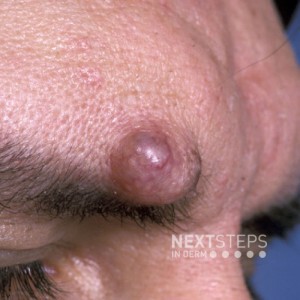
The correct answer is B. Fibroepithelioma of Pinkus.
This is a fibroepithelioma of Pinkus, which is a BCC. Therefore, it has clefting between the reticulate strands and the stroma.
Fibroepithelioma of Pinkus, also known as Pinkus tumor and Pinkus epithelioma, is a premalignant fibroepithelial tumor first that was described by Hermann Pinkus in 1953. Originally classified as a rare variant of basal cell carcinoma, a malignant neoplasm, it has since been controversially reclassified as a trichoblastoma, a benign neoplasm.
Clinically, fibroepithelioma of Pinkus may resemble a range of benign skin tumors that are not routinely excised.
Fibroepithelioma of Pinkus typically presents as a single, erythematous or flesh-colored, dome-shaped papule or plaque. Large pedunculated, ulcerated, cystic, and pleomorphic variants with different pigmentation combinations have also been reported.
Unlike in BCC, there have been no reports of spontaneous bleeding in fibroepithelioma of Pinkus.
The gold standard diagnostic test for fibroepithelioma of Pinkus is a skin biopsy taken for histopathological examination. Fibroepithelioma of Pinkus is characterized by interconnected, branching strands of basaloid cells embedded by a loose, richly vascularized fibrous stroma, extending from the epidermis down into the dermis.
